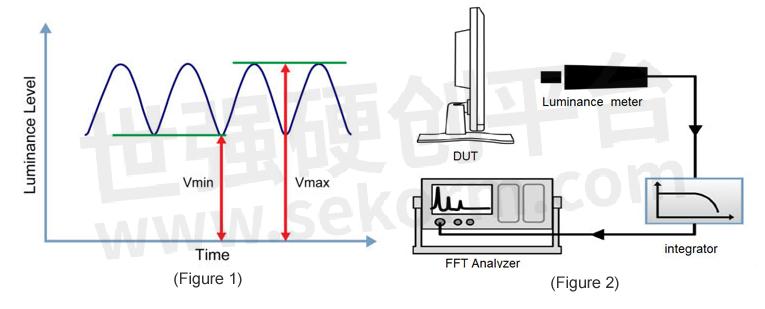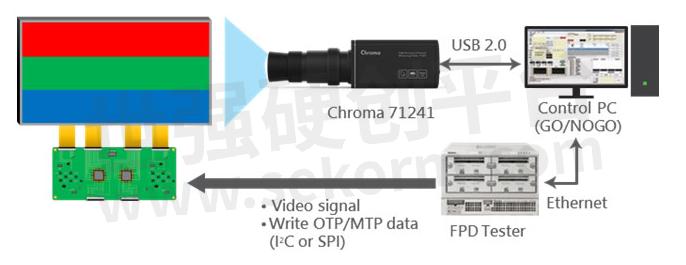Chroma 71241 High-Precision Universal Measurement Probe Paired with Modular FPD Tester Offers Cost-effective Automatic Flicker Measurement Solution

Flickering light is a potential problem for any electroluminescent device. Due to its particular physiological makeup, the human eye can create a kind of afterimage in the process of catching light and shadow. When our eyes perceive a light source that flickers more than 10 times per second, the afterimage produced by this process can cause the eye to continue to perceive the shimmering light. This can be an uncomfortable sensation, which will only start to gradually disappear when the flicker occurs at a rate higher than 30 times per second.
What is flicker?
Continuously supplying a DC signal to an LCD causes its performance to deteriorate rapidly. This is why LCD displays are driven by an AC signal that switches between negative and positive voltage every frame. When the AC-driven LCD has an adjusted reference voltage (Vcom) with a difference between the positive (V+) and negative (V-) components, a shimmering effect is produced that can be detected by the human eye, which is referred to as "flicker". Each time the gray scale of the panel is updated, the brightness will fluctuate slightly, causing the viewer to perceive a flickering screen.
How do you measure flicker?
VESA and JEITA have defined two methods for measuring the flicker degree. Let's take a look at the VESA method first.
If the brightness of the LCD changes as shown in Figure 1, the VESA FMA (Flicker Modulation Amplitude) calculation formula is as follows:
FMA = AC/DC= (Vmax-Vmin)/[ (Vmax+Vmin)/2 ]X100%

The JEITA measurement method (shown in Figure 2) uses a luminance meter to measure the center of the screen. The data measured by the meter is sent to the filter that corresponds to the human eye's perception of flicker. The data is output to the FFT analyzer, which is then used to obtain the distribution of power at different frequencies, calculated as follows:
JEITA = 10*log (Px/P0)[dB]
P0 denotes the power spectrum at frequency 0, and Px denotes the power spectrum at different frequencies.
How do you fix flicker?
In FMA display mode, there is no way to know at which frequency the flicker is generated, because this mode only calculates the ratio between the AC and DC components of the luminance. However, the human eye's sensitivity to flicker decreases from 30Hz upwards, and when the frequency exceeds 60Hz, our eyes won't detect any flicker at all.

CHROMA 71241 high-precision universal measurement probe can accurately measure the flicker value of the display in compliance with the measurement methods established by VESA and JEITA and allows users to switch between the two measurement modes. The probe can be paired with Chroma's modular Flat Panel Display Tester (FPD Tester) to achieve automatic flicker adjustment, offering a high value-added and cost-effective automatic measurement solution.

Chroma 71241 can also accurately measure the luminance and color performance of TVs, monitors, and panels. Its optical measurement software provides a comprehensive solution for optical inspection, allowing users to measure chromaticity, brightness, uniformity, flicker, and gamma as well as edit the test program.
- +1 Like
- Add to Favorites
Recommend
- Chroma Launches Next-Generation High-Performance Power IC Test Platform Chroma 3650-S2 Equipped with up to 768 pins, 200Mbps data rate
- Chroma Test Setup for Complete Gamma Measurement on Video Signal Generators
- Chroma Regenerative Test Solutions Accelerate Net-Zero Transition
- Chroma ATE Showcases Advanced Test Technology to Propel the AI Revolution at SEMICON Taiwan 2023
- Sekorm Became an Official Authorized Distributor of Chroma
- Chroma ATE Inc. Featured in Forbes Asia‘s Best Under A Billion 2023, Showcasing Consistent Top- and Bottom-Line Growth
- 8610 Battery Pack Integrated Testbed for Testing New Energy Vehicle Battery Systems and Subparts | Chroma
- Chroma 62000d Programmable Bidirectional Dc Power Supplies Have Both Power Source and Load Characteristics
This document is provided by Sekorm Platform for VIP exclusive service. The copyright is owned by Sekorm. Without authorization, any medias, websites or individual are not allowed to reprint. When authorizing the reprint, the link of www.sekorm.com must be indicated.





























































































































































































































































































































































































































































































































































































































































































































































































































































































